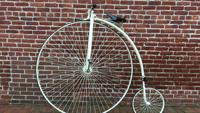In 1884, the world was much larger than it is today. There were hostile territories, many regions were poorly mapped, and highways were yet to traverse continents.
Sounds like the perfect time to ride a bicycle around the world.
Thomas Stevens was up for the adventure after moving to Denver and taking up the cycling sport on large-wheeled bicycles, fittingly known at the time as boneshakers. These bikes had no brakes, no suspension, iron wheels and little room for error. Getting on was challenging, and falling off meant a few bruises and scuffs.
No worries: The penny-farthings, as they were properly named, were not very fast. For Stevens, that was probably a good thing since he would travel primarily on horse roads and walking paths on a vehicle that was a far cry from today’s mountain bikes.
Stevens left San Francisco supplied with whatever he could fit on his handlebars. The first leg of the journey ahead was over 3,700 miles. He made it to Boston in 103 days, having to walk a lot of those miles on roads that didn’t accommodate wheels.
He stayed the winter in Boston, probably loading up on carbohydrates, then took a steamer to Liverpool, where he resumed his ride. A crowd of fans and fellow riders showed up to cheer him on and escort him through the countryside. He had become an ambassador for the sport, and people were anxious to meet the man with chutzpah enough to pedal into the unknown.
Once through Europe, Stevens made his way through Kurdistan, Iraq and Iran. He relied on the hospitality of people he met and was careful not to raise any ire since the region was still simmering from a recent Kurdish rebellion. The trails in the Middle East were mainly for pack animals and carts, so he navigated the mountainous landscapes by pushing the heavy bicycle along. Food and water were scarce.
At a time when governments were shifting and conquering, geographies and borders expanding, Stevens didn’t set out to prove national superiority, gain subjects or win converts. He simply wanted to see the world and meet its people.
Lucky for us, he was also a clever writer and documented his travels. He had a dry wit when describing setbacks and harrowing episodes, but also a poetic sense when describing the scenery new to his eye: “A profusion of peach, pear and almond orchards enlivens the landscape with a wealth of pink and white blossoms, and fills the balmy spring air with a subtle, sensuous perfume that savors the tropical clime.”
The journey would take Stevens nearly three years. He covered 13,500 miles. He eased across Europe, got arrested in Afghanistan, sweat profusely in the summer across India, and nearly got killed in China. He traveled with only a change of clothes, a poncho and a pistol.
When his odyssey was over, he told a reporter, “I think human nature is pretty much the same the world over.”
Feats large and small bring our appreciation to the little things — like just how much every member of the human race has in common.
The Foundation for a Better Life promotes positive values to live by and pass along to others. Go to PassItOn.com.




 Your Privacy Choices
Your Privacy Choices